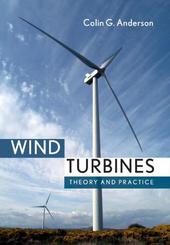
|
Wind Turbines: Theory and Practice
Hardback
Main Details
Description
In the multi-disciplinary field of wind energy, students and professionals can often be uncomfortable outside their own specialist areas. This essential textbook explains the key aspects of wind turbine technology and its application in a single readable text. Covering a broad range of multi-disciplinary topics, including everything from aerodynamics through to electrical and control theory, to structures, planning, economics, and policy, this reference is an excellent toolkit for undergraduate students, postgraduate students, and professionals in the field of wind energy. Key concepts, including more challenging ones such as rotational sampling of turbulence, vortex wake structures, and reactive power management, are explained using clear language and simplifying illustrations including experimental graphs, photos, and line drawings.
Author Biography
Colin G. Anderson is a consulting engineer specialising in renewable energy technology and an adjunct lecturer at the School of Engineering, University of Edinburgh, where he teaches a course entitled Principles of Wind Energy.
Reviews'A very clear, accurate, informative and interesting account. I wish I had read it 15 years ago!' Nicholas Gubbins, Community Energy Scotland 'Lucid and insightful, well set out and well thought out, this is a great textbook covering all the key aspects of wind turbine design and use.' Peter Jamieson, Strathclyde University 'Multidisciplinary overview of wind energy technology, based on personal experience. A lifetime in wind energy, provides relevant up-to-date practical information.' Jaap de Boer, Energy Watch NL 'Dr Colin Anderson's book on theory and practice of wind turbines is an excellent treatment of everything from the wind climate statistics, aerodynamics, composite construction materials, blade manufacture, generator types, grid connection and economics. It has excellent graphs and diagrams, one on every page, valuable references and clearly explained algebra and is strongly recommended for everyone in this vitally important industry.' Stephen Salter, University of Edinburgh 'I have been teaching wind energy courses at University level for almost twenty years. 'Wind Turbines: Theory and Practice' explains the theory carefully and contains valuable industry insights. It went straight onto the list of recommended reading for my students.' Jonathan Whale, Murdoch University 'A brief history of wind turbine technology introduces the first principles of the theory, and physics of converting torque from the wind to electrical energy. This is an excellent technical introduction for those pursuing an understanding and interest in wind turbine design, deployment and optimizing performance.' Bob Sherwin, EAPC Wind Energy Services, Vermont 'The author takes the reader through the fundamentals of wind turbine engineering in a clear, concise and engaging way. He [...] introduces some of the fundamental engineering challenges, such as fatigue and noise, that hampered early designs, as well as key insights that enabled greater energy production efficiency, such as advances in aerodynamic theory, control theory and materials science. Clear and easy-to-understand explanations are given for the complex drivers of wind, as well as common models used for its characterisation. This enables the reader to understand the context for high-level decision making, such as where to site wind turbines and how to estimate available wind energy. Overall, this book provides an excellent handbook for anyone who seeks to build their understanding of wind turbine design, both engineers and non-engineers alike.' Institution of Civil Engineers
|